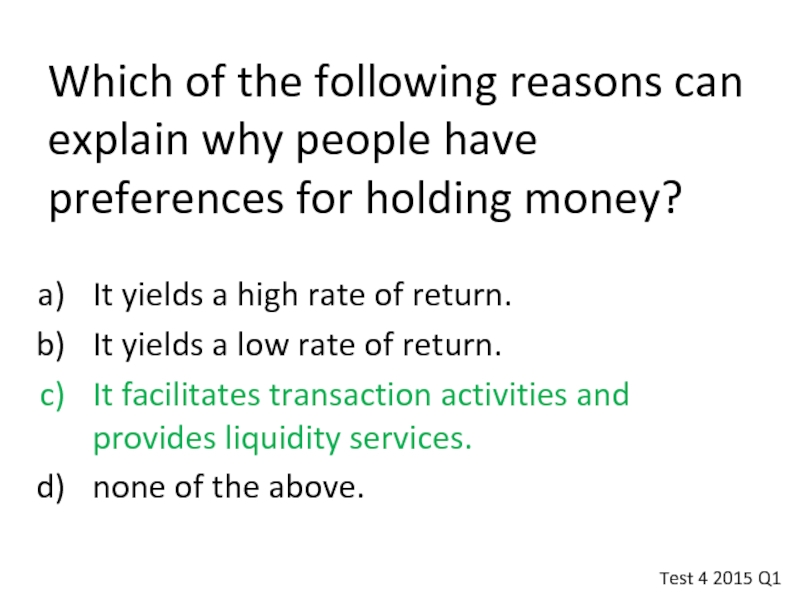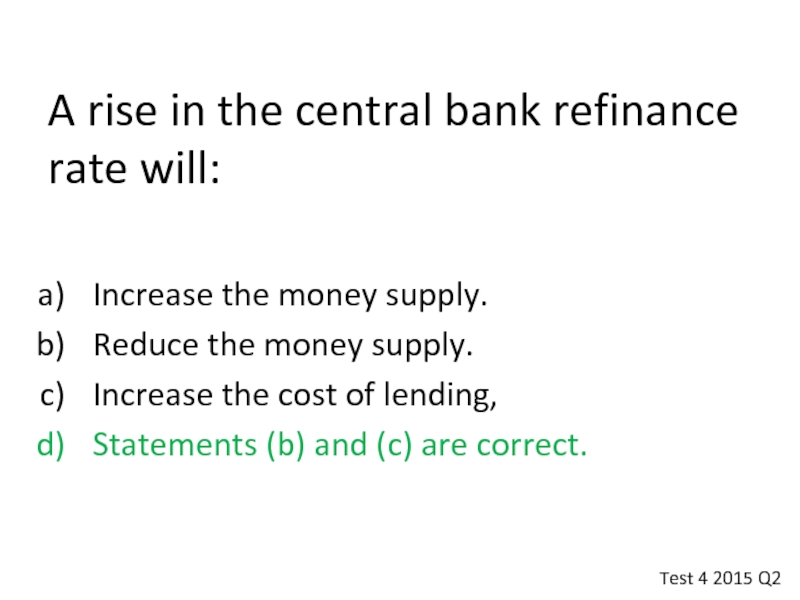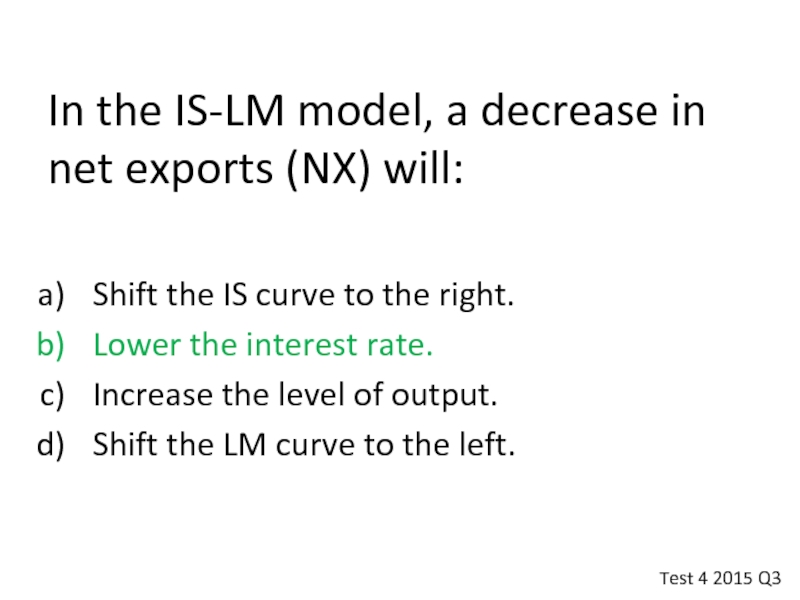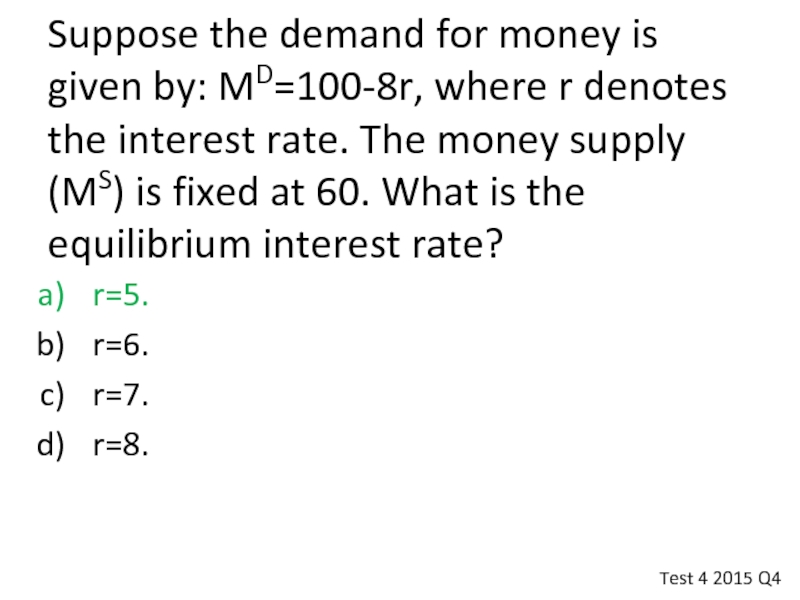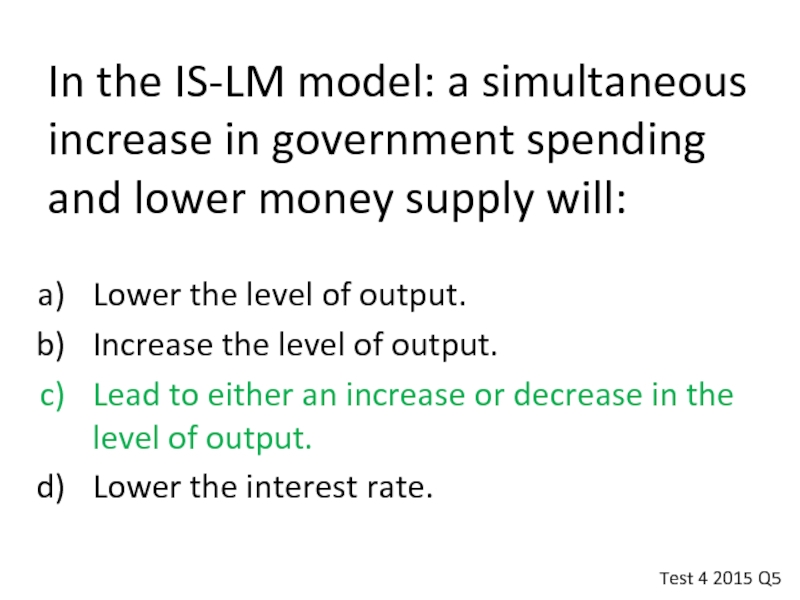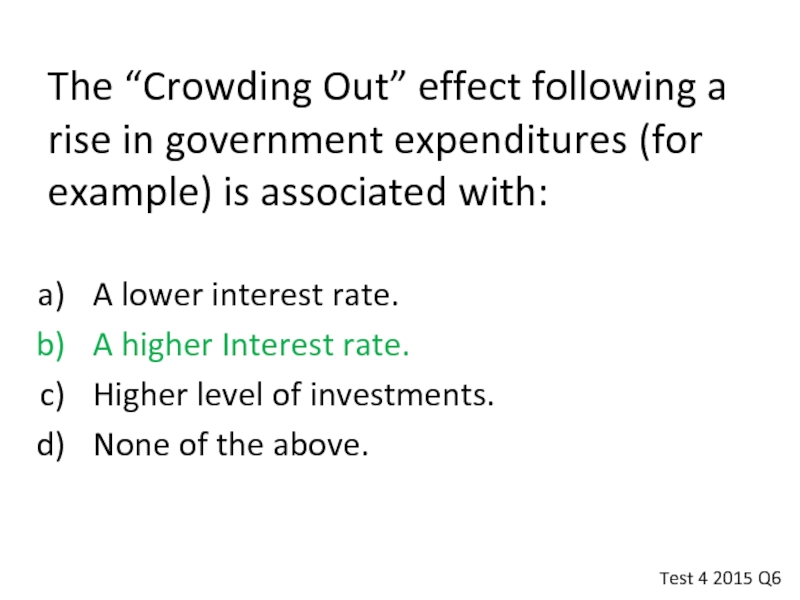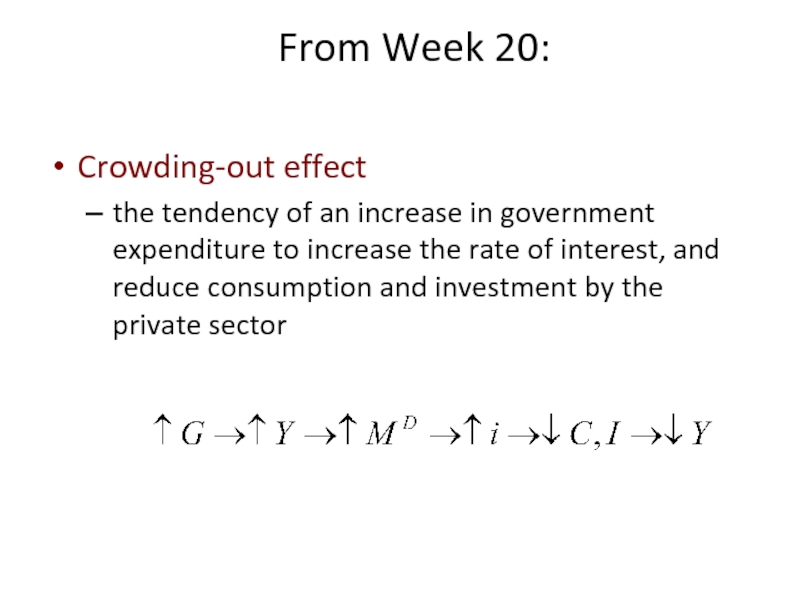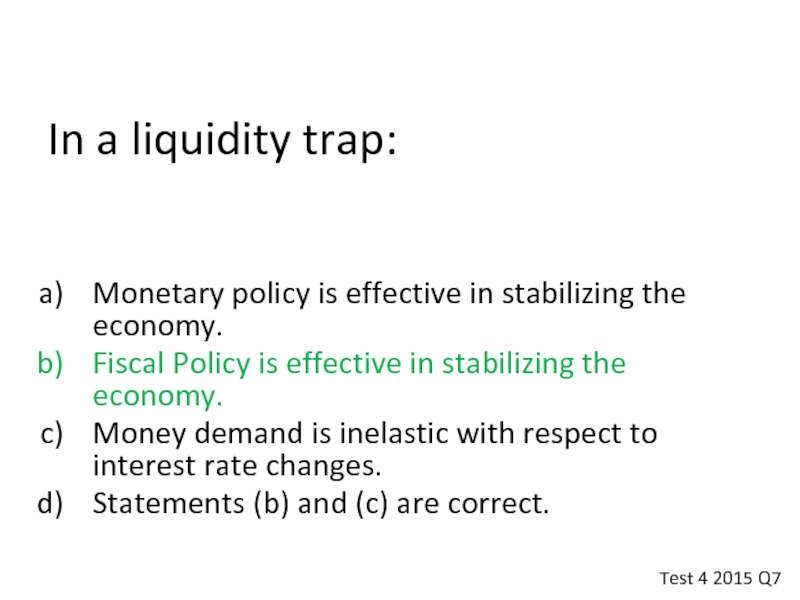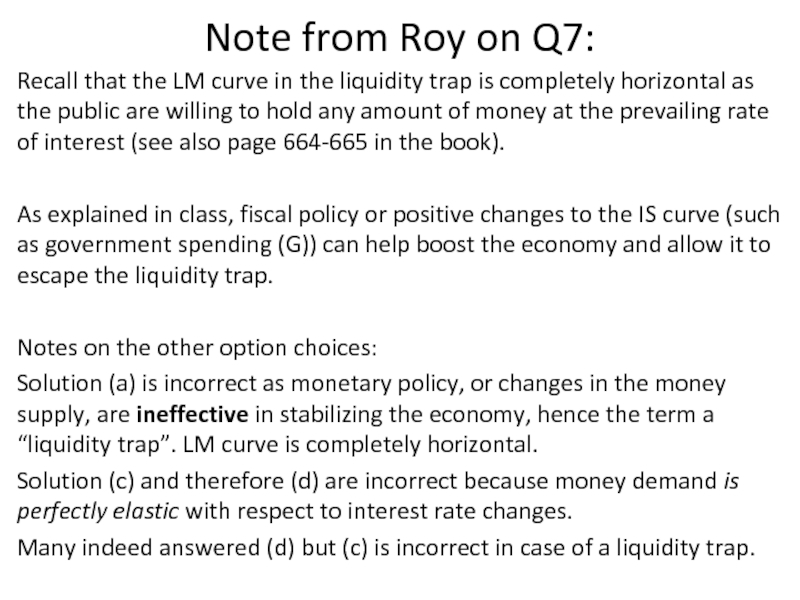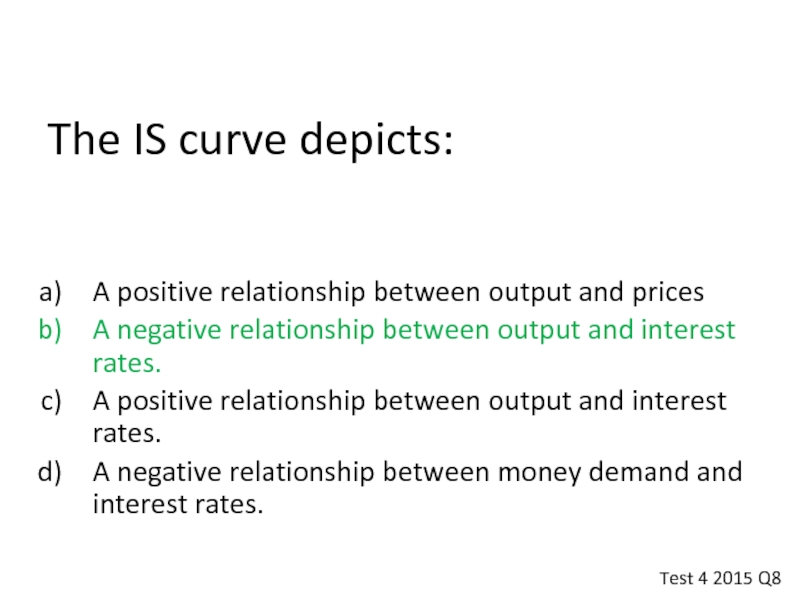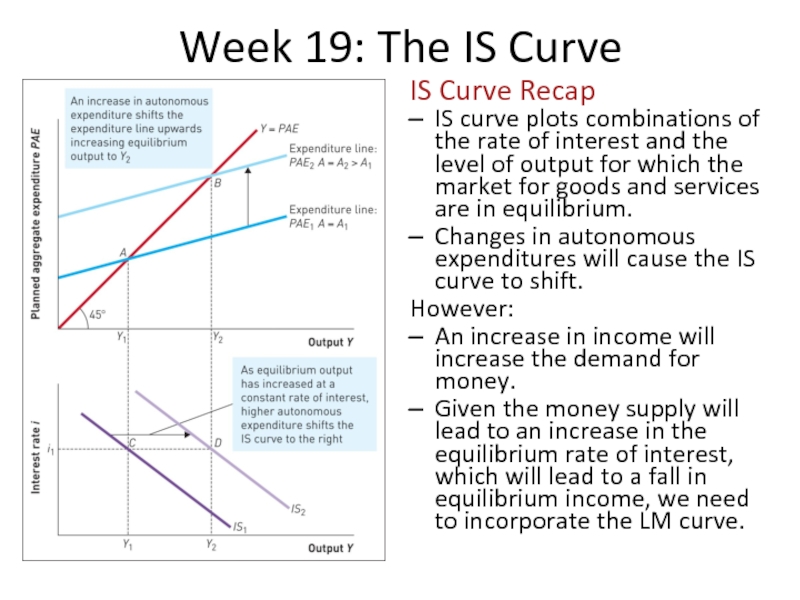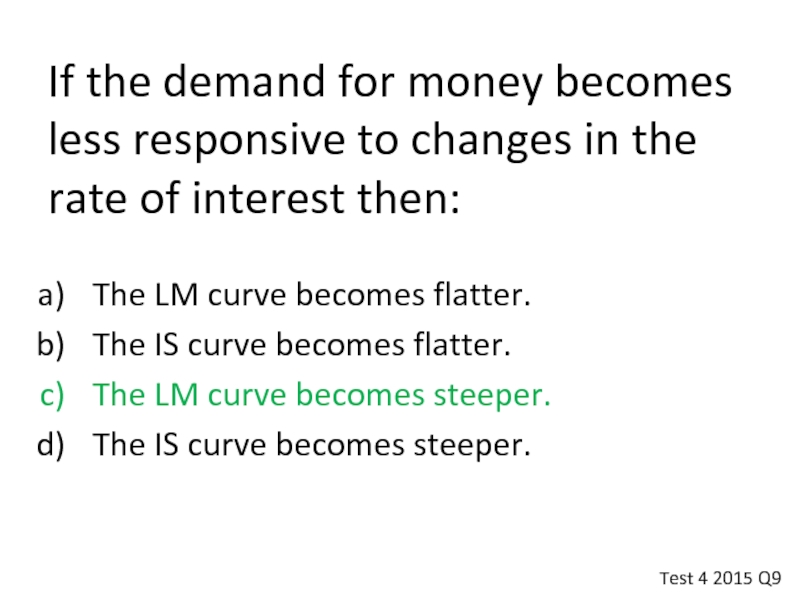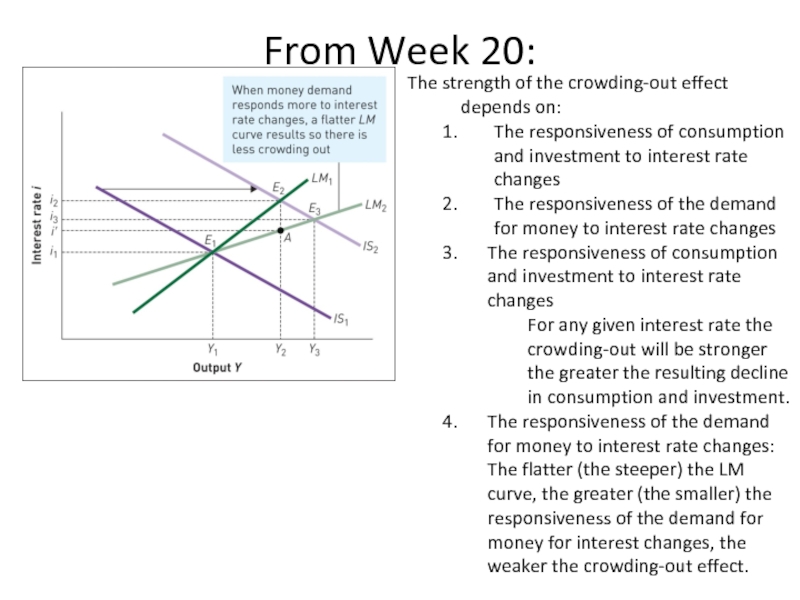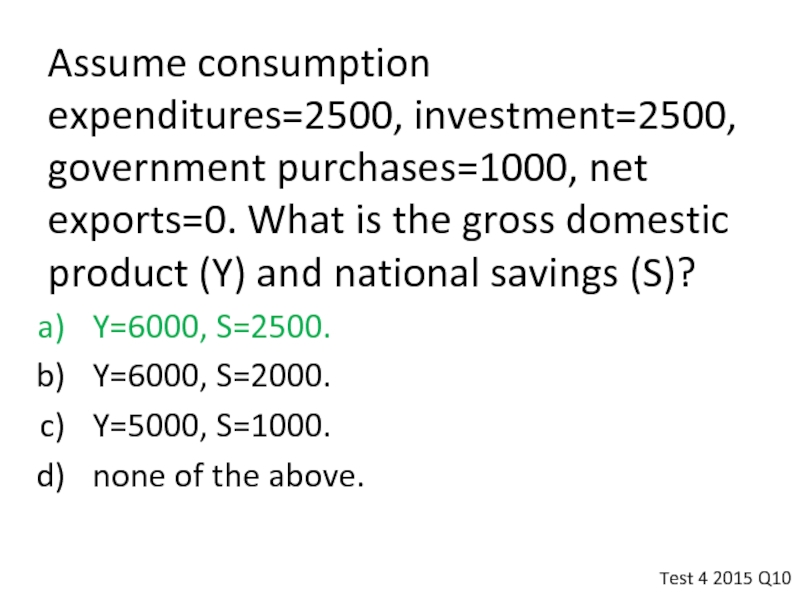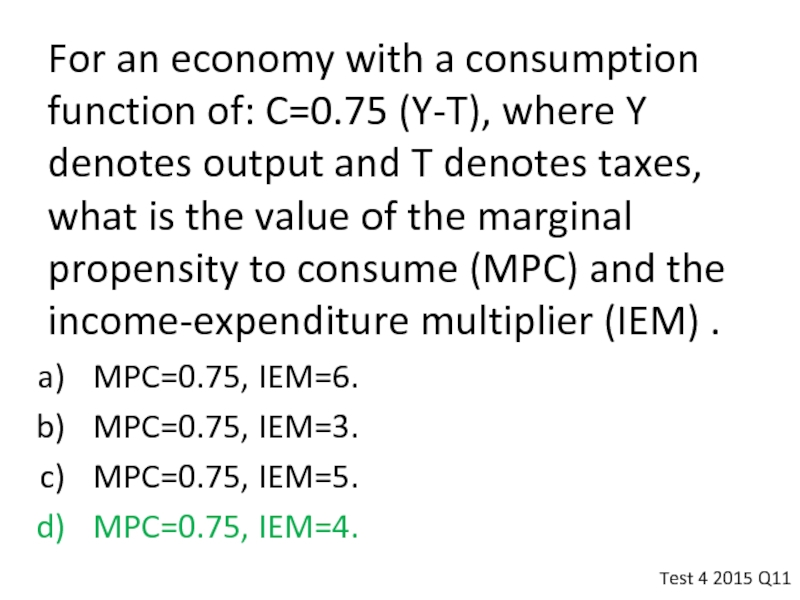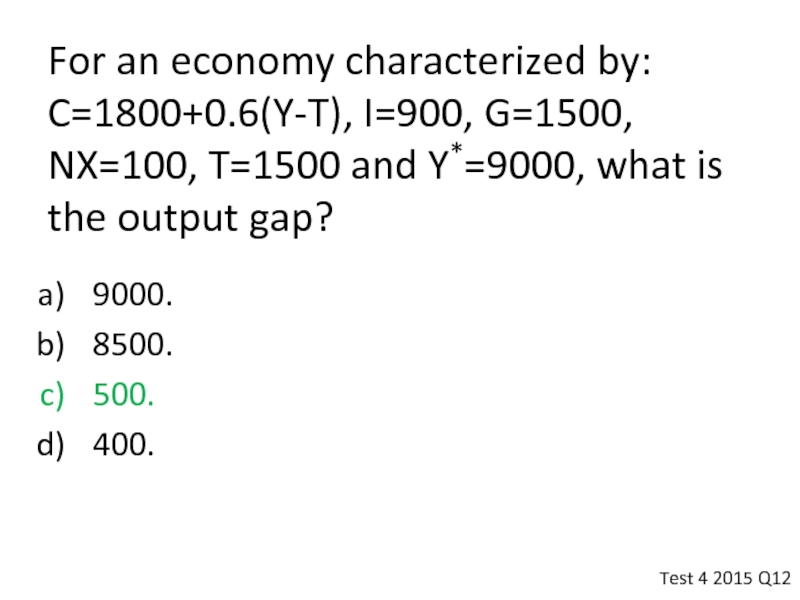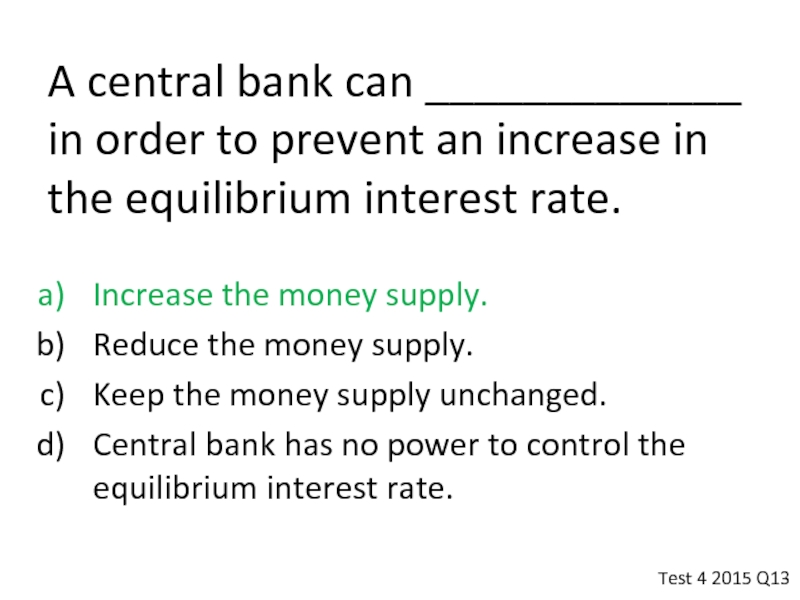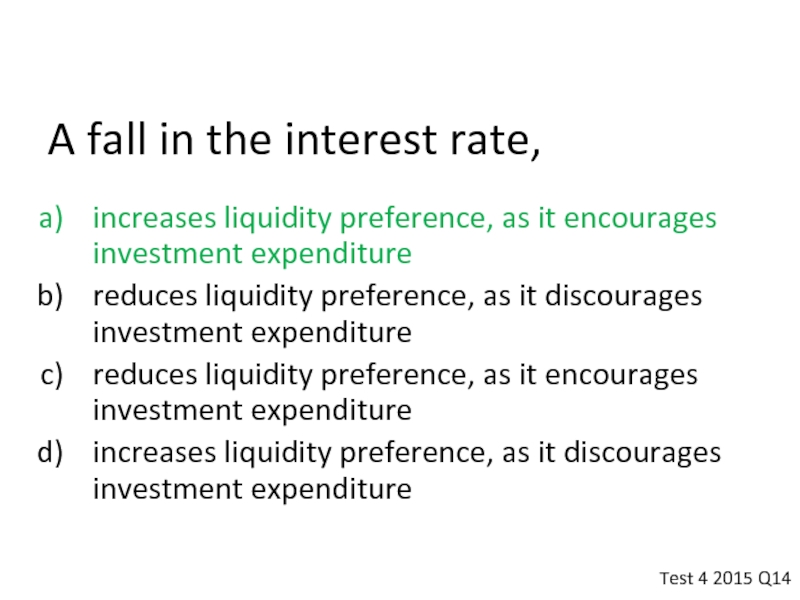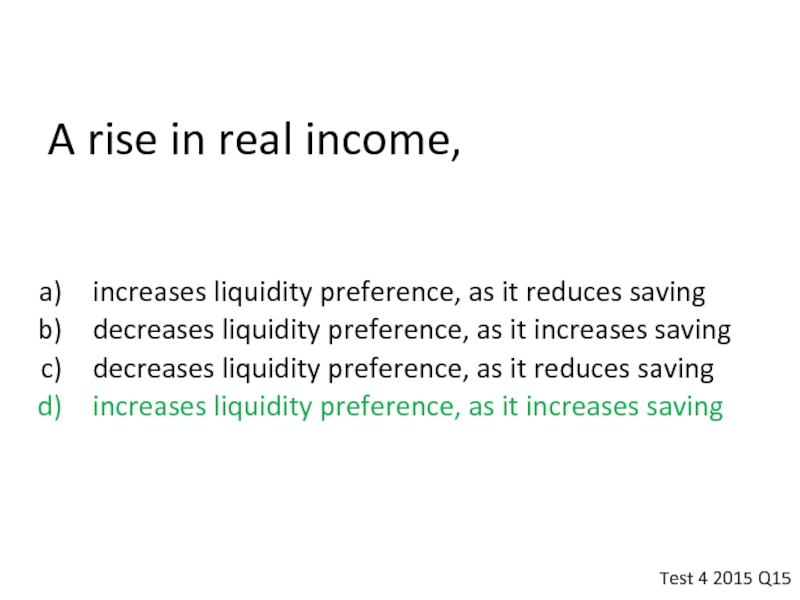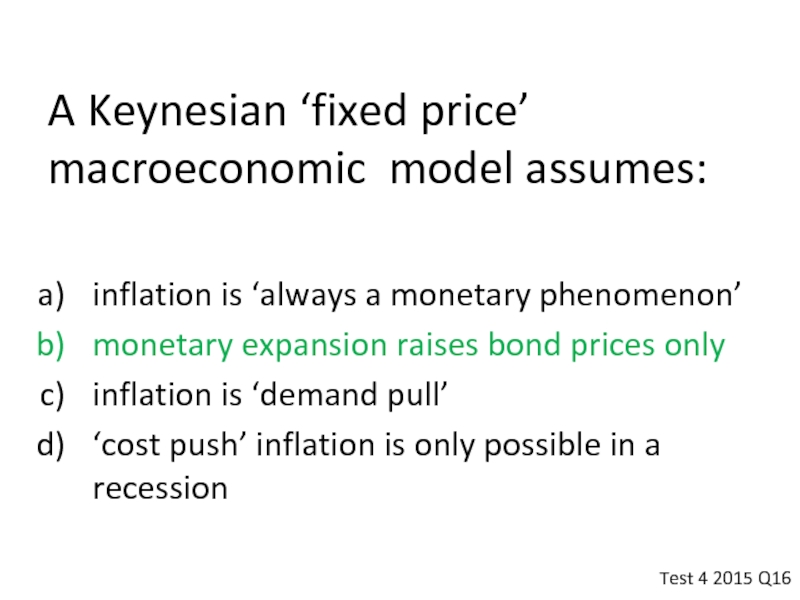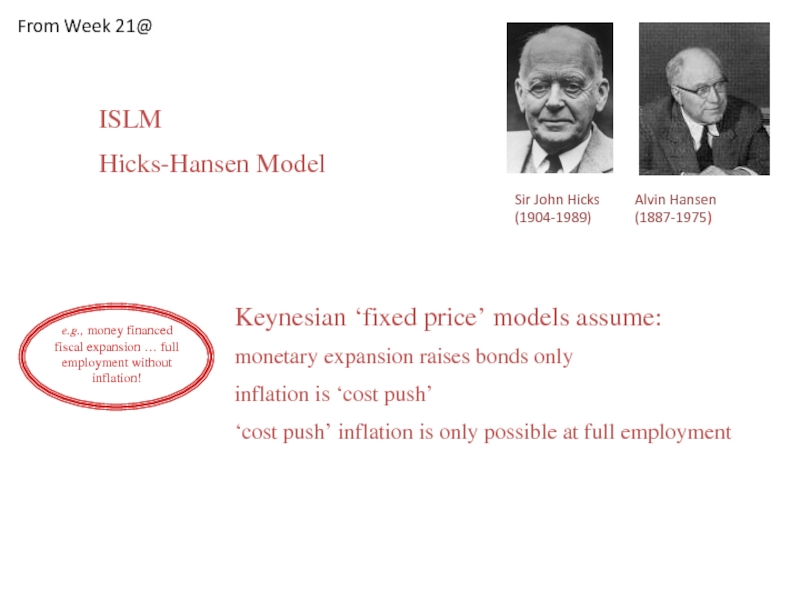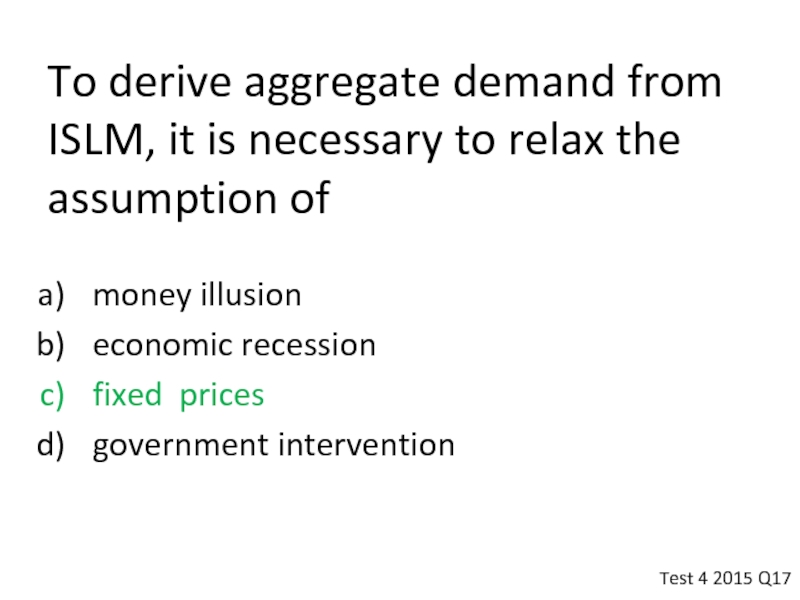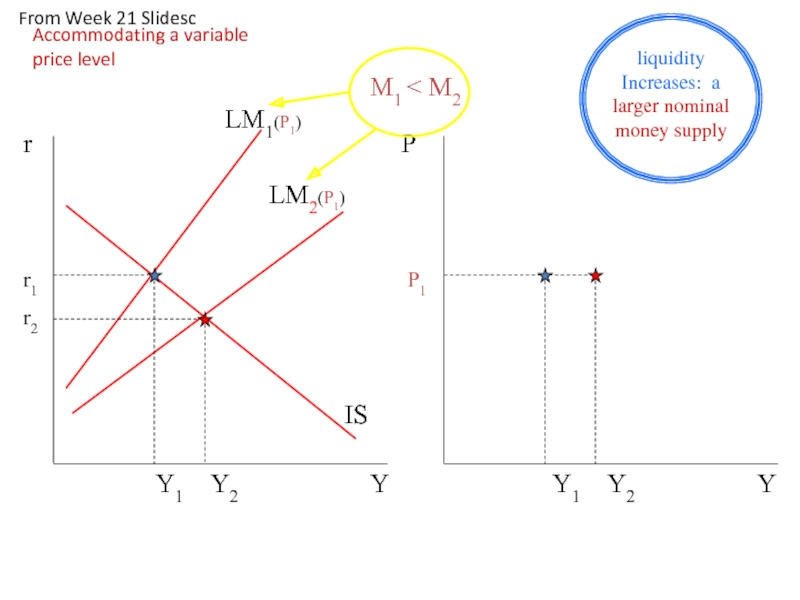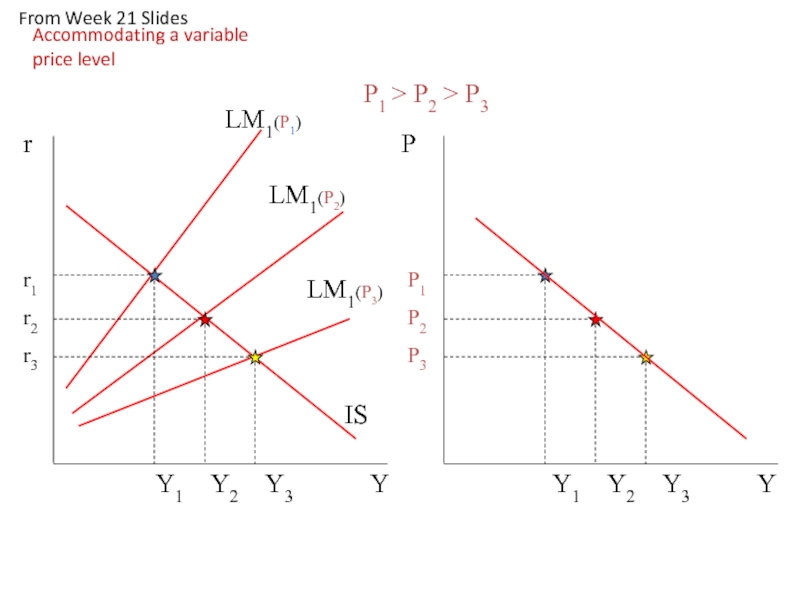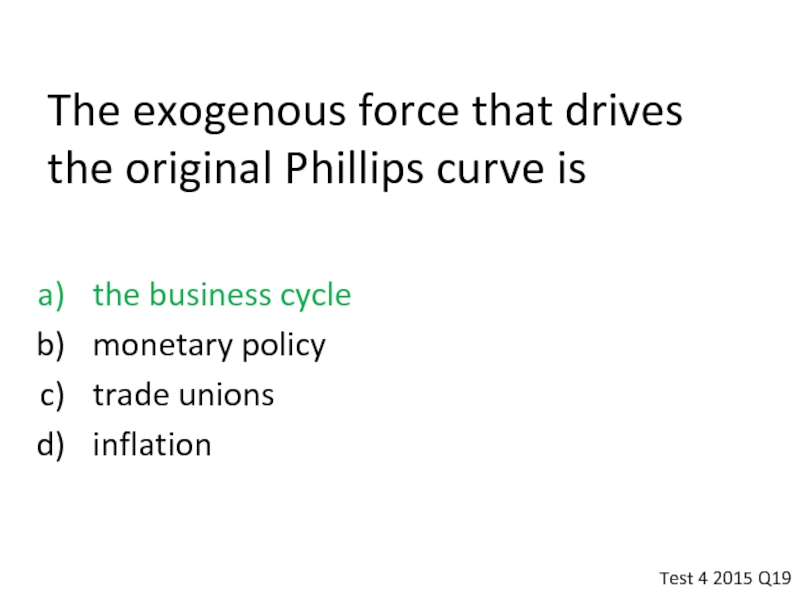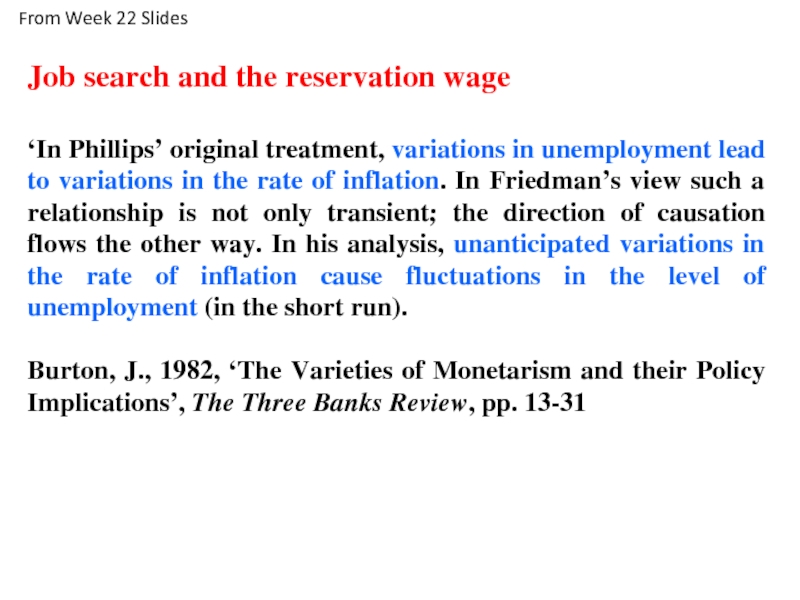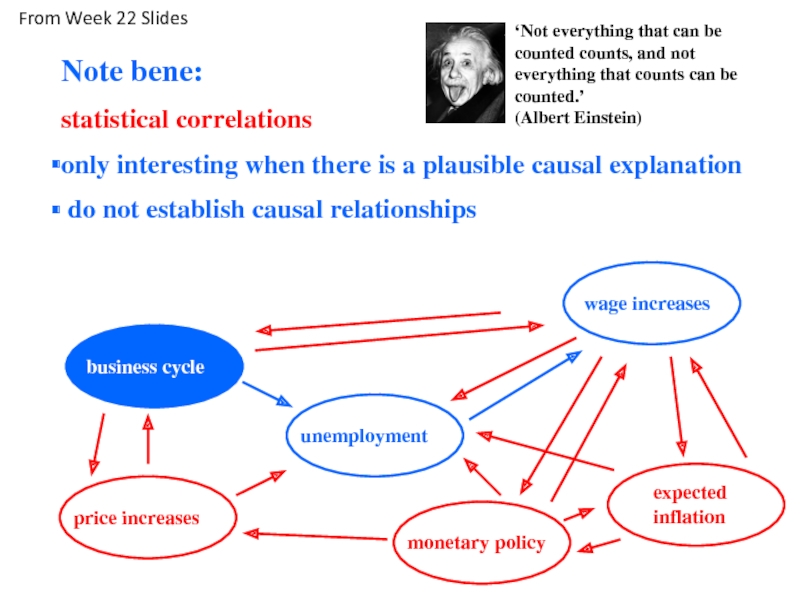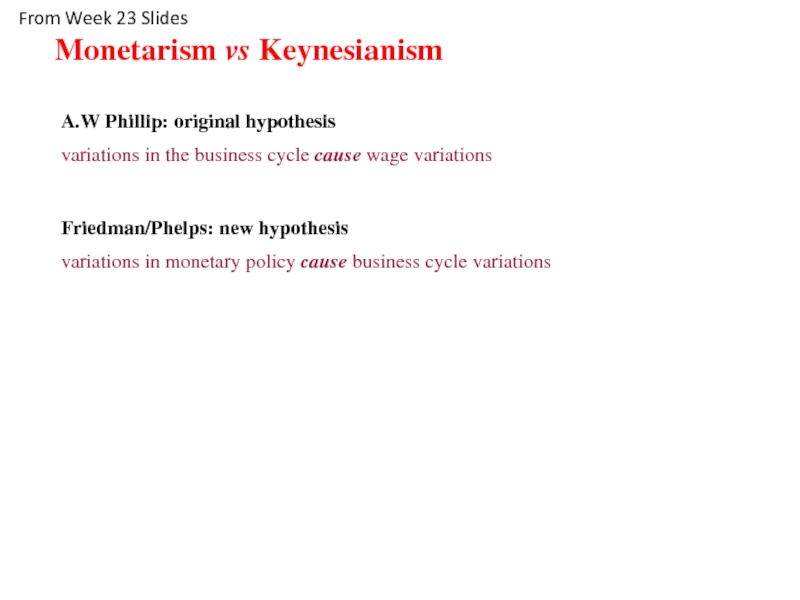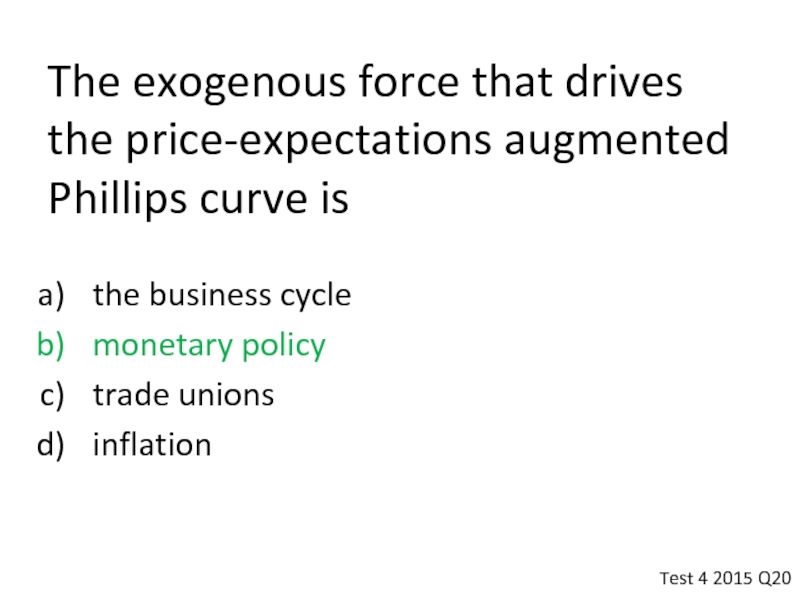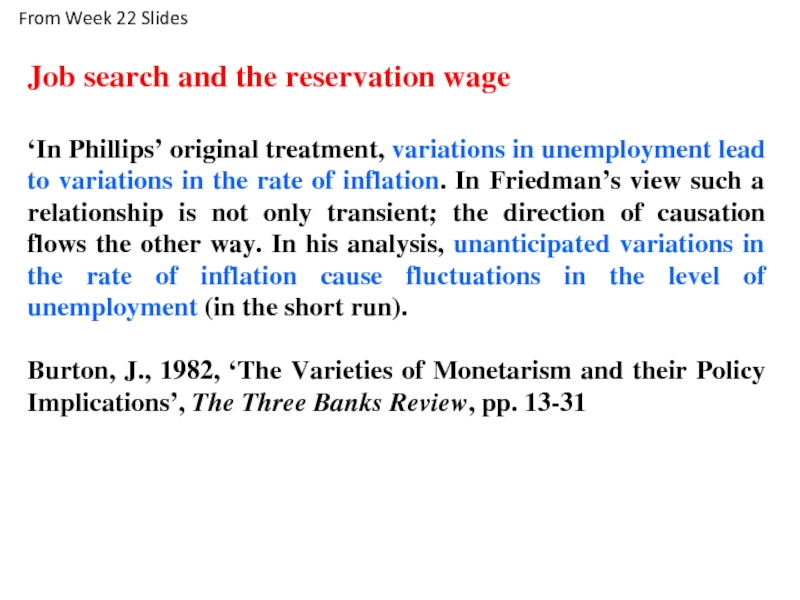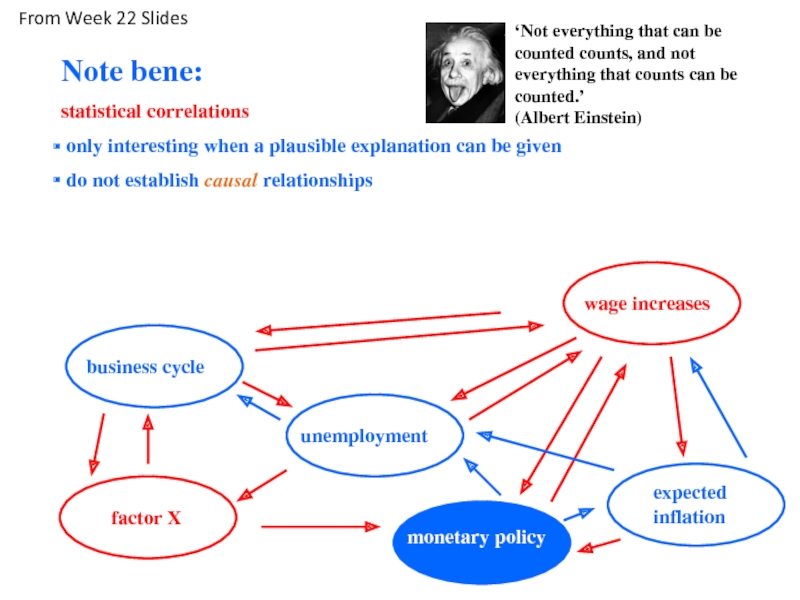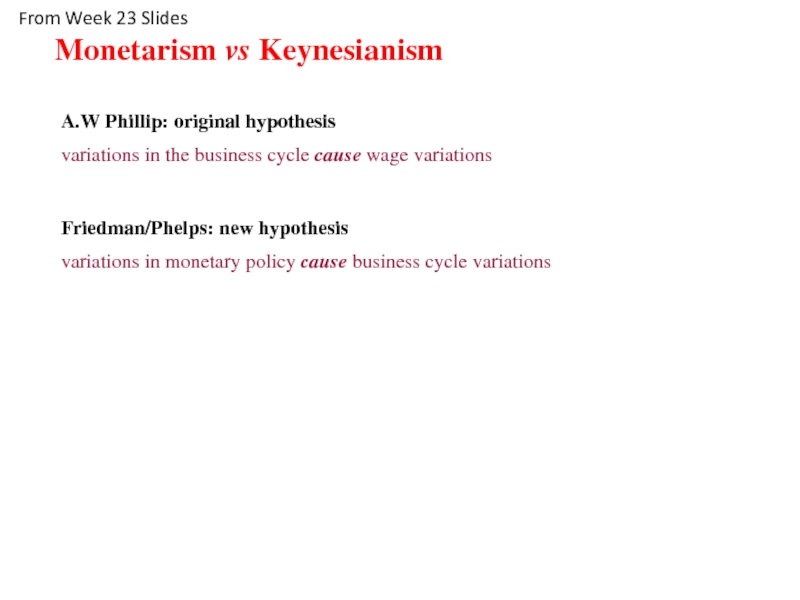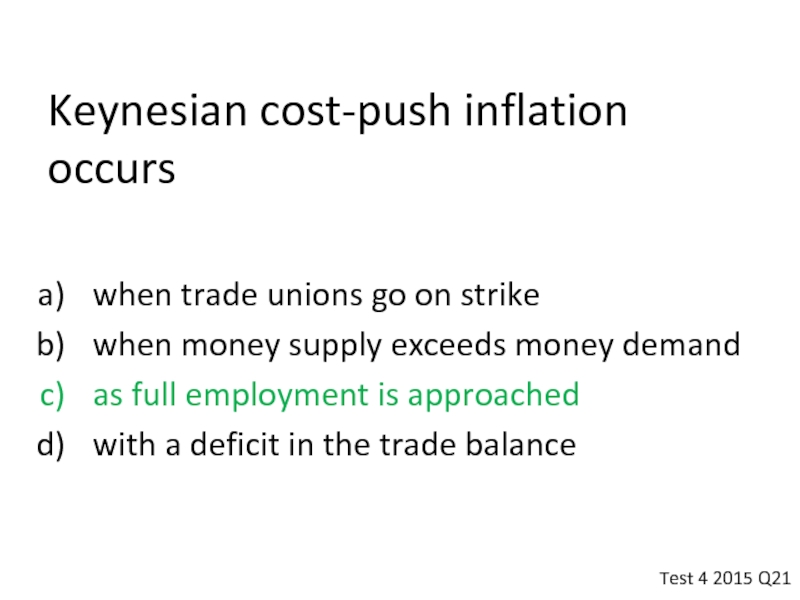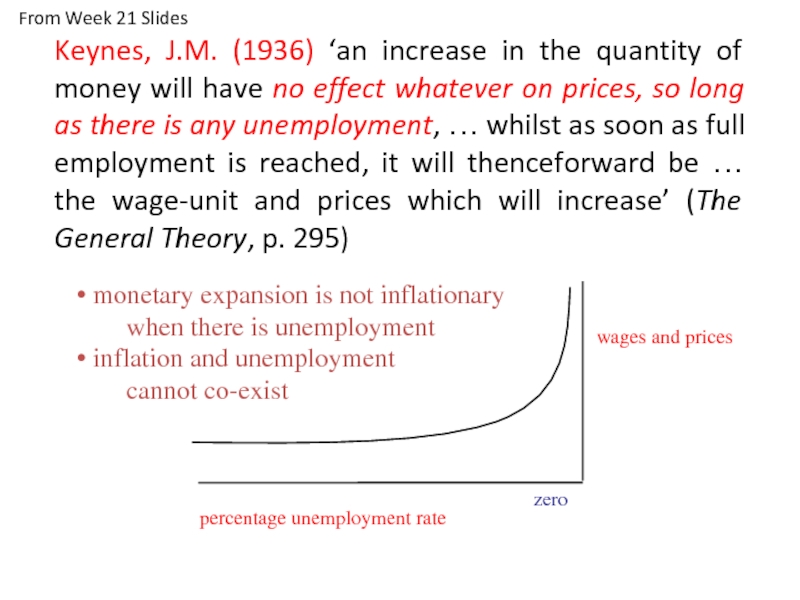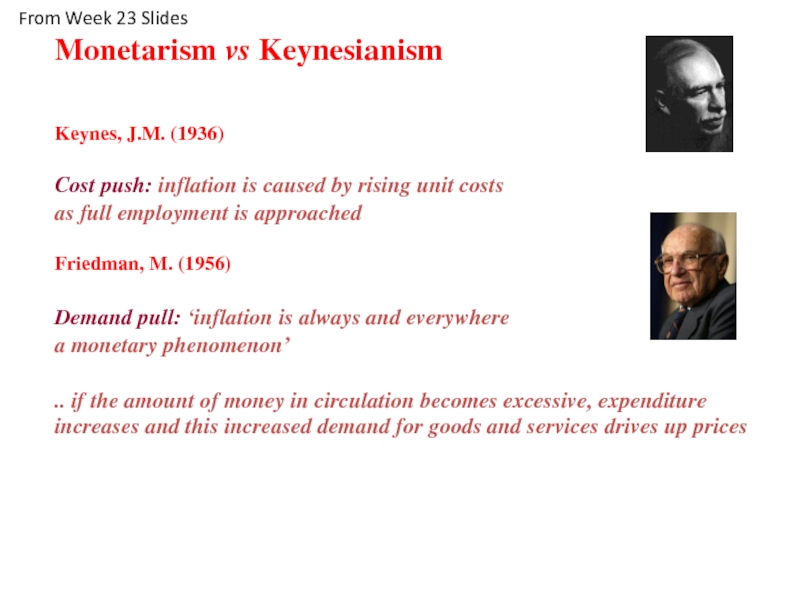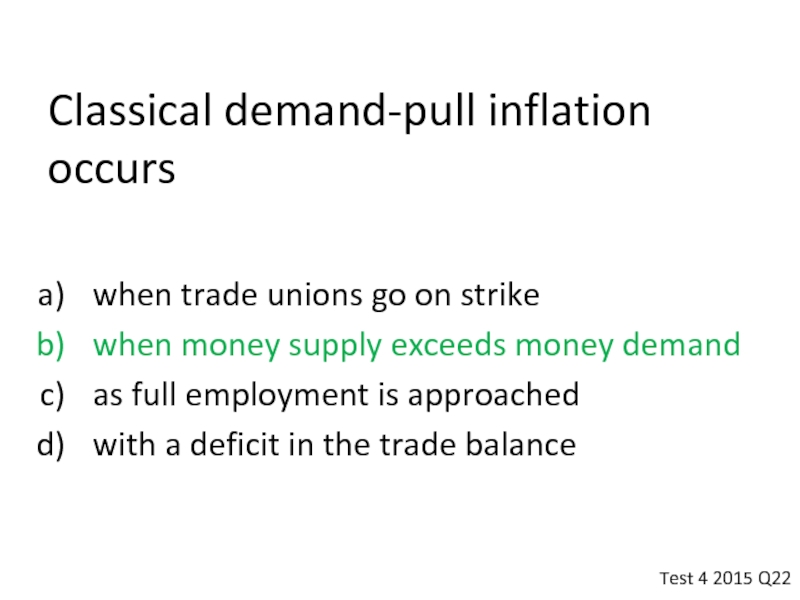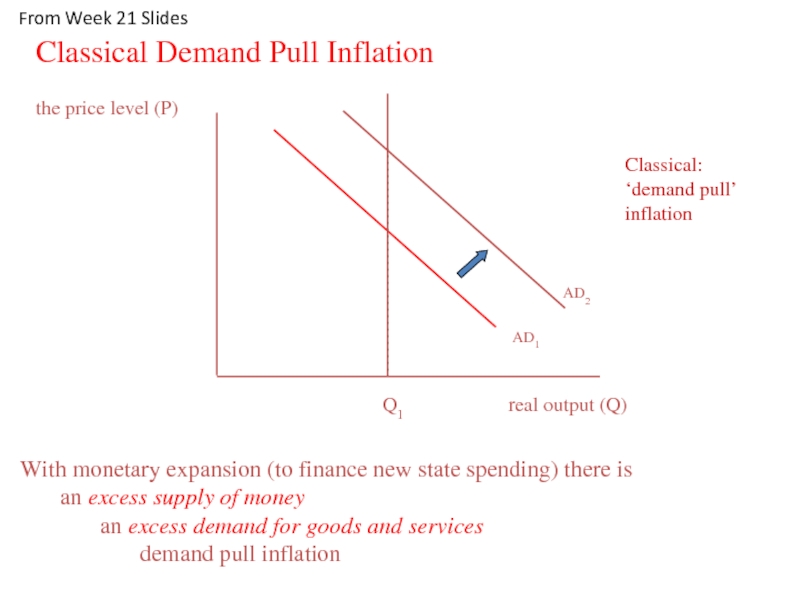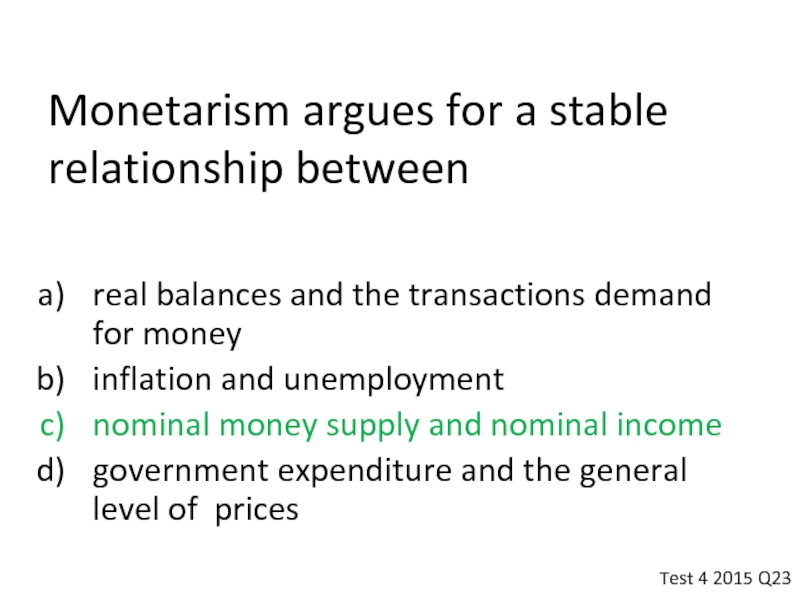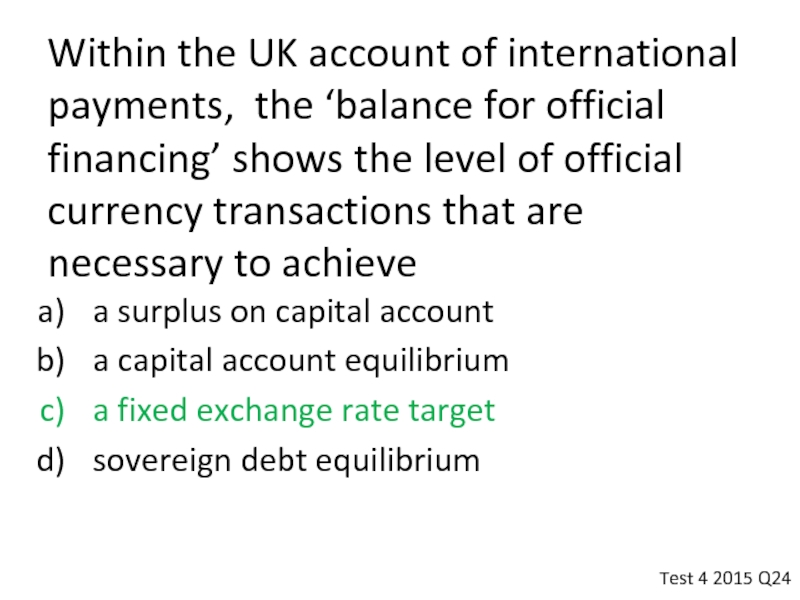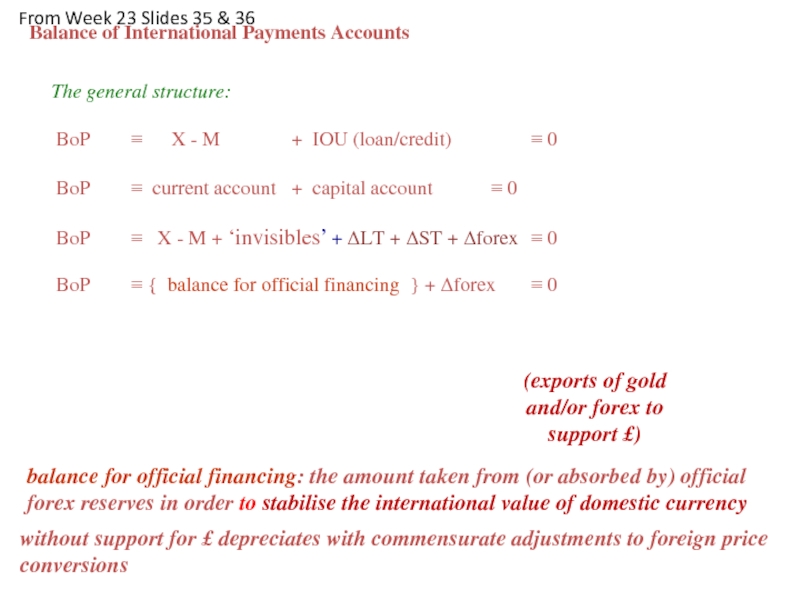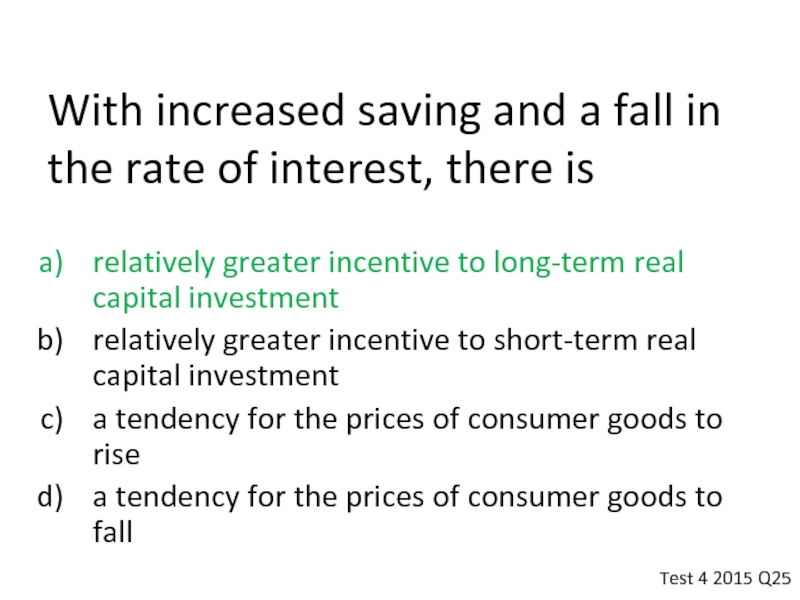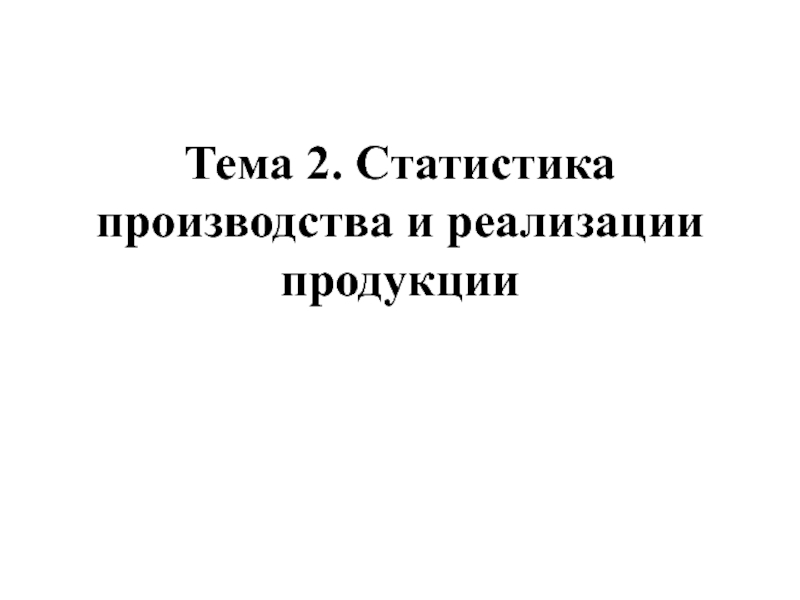- Главная
- Разное
- Дизайн
- Бизнес и предпринимательство
- Аналитика
- Образование
- Развлечения
- Красота и здоровье
- Финансы
- Государство
- Путешествия
- Спорт
- Недвижимость
- Армия
- Графика
- Культурология
- Еда и кулинария
- Лингвистика
- Английский язык
- Астрономия
- Алгебра
- Биология
- География
- Детские презентации
- Информатика
- История
- Литература
- Маркетинг
- Математика
- Медицина
- Менеджмент
- Музыка
- МХК
- Немецкий язык
- ОБЖ
- Обществознание
- Окружающий мир
- Педагогика
- Русский язык
- Технология
- Физика
- Философия
- Химия
- Шаблоны, картинки для презентаций
- Экология
- Экономика
- Юриспруденция
Economics exam презентация
Содержание
- 1. Economics exam
- 2. Today’s Outline We’ll review the exam from Friday
- 3. Which of the following reasons can explain
- 4. A rise in the central bank refinance
- 5. In the IS-LM model, a decrease in
- 6. Suppose the demand for money is given
- 7. In the IS-LM model: a simultaneous increase
- 8. The “Crowding Out” effect following a rise
- 9. Crowding-out effect the tendency of an increase
- 10. In a liquidity trap: Monetary policy is
- 11. Note from Roy on Q7: Recall that
- 12. The IS curve depicts: A positive relationship
- 13. Week 19: The IS Curve IS Curve
- 14. If the demand for money becomes less
- 15. From Week 20: The strength of the
- 16. Assume consumption expenditures=2500, investment=2500, government purchases=1000, net
- 17. For an economy with a consumption function
- 18. For an economy characterized by: C=1800+0.6(Y-T), I=900,
- 19. A central bank can _____________ in order
- 20. A fall in the interest rate,
- 21. A rise in real income, increases
- 22. A Keynesian ‘fixed price’ macroeconomic model assumes:
- 23. Sir John Hicks Alvin Hansen
- 24. To derive aggregate demand from ISLM, it
- 25. Y r LM1(P1) LM2(P1) Y P1
- 26. Y r LM1(P2) Y P1
- 27. Y r LM1(P2) LM1(P3) Y P1
- 28. The aggregate supply curve is drawn under
- 29. The exogenous force that drives the original
- 31. Note bene: statistical correlations
- 33. The exogenous force that drives the price-expectations
- 35. Note bene: statistical correlations
- 37. Keynesian cost-push inflation occurs when trade unions
- 39. Monetarism vs Keynesianism Keynes, J.M.
- 40. Classical demand-pull inflation occurs when trade unions
- 41. Monetarism vs Keynesianism Keynes, J.M.
- 43. Monetarism argues for a stable relationship between
- 44. Within the UK account of international payments,
- 45. The general
- 46. With increased saving and a fall in
- 47. Last Class! Good luck on the Final Exam. Have a great summer.
Слайд 1ECON 102 Tutorial: Week 25
Shane Murphy
www.lancaster.ac.uk/postgrad/murphys4/econ15
s.murphy5@lancaster.ac.uk
Слайд 3Which of the following reasons can explain why people have preferences
It yields a high rate of return.
It yields a low rate of return.
It facilitates transaction activities and provides liquidity services.
none of the above.
Test 4 2015 Q1
Слайд 4A rise in the central bank refinance rate will:
Increase the money
Reduce the money supply.
Increase the cost of lending,
Statements (b) and (c) are correct.
Test 4 2015 Q2
Слайд 5In the IS-LM model, a decrease in net exports (NX) will:
Shift the IS curve to the right.
Lower the interest rate.
Increase the level of output.
Shift the LM curve to the left.
Test 4 2015 Q3
Слайд 6Suppose the demand for money is given by: MD=100-8r, where r
r=5.
r=6.
r=7.
r=8.
Test 4 2015 Q4
Слайд 7In the IS-LM model: a simultaneous increase in government spending and
Lower the level of output.
Increase the level of output.
Lead to either an increase or decrease in the level of output.
Lower the interest rate.
Test 4 2015 Q5
Слайд 8The “Crowding Out” effect following a rise in government expenditures (for
A lower interest rate.
A higher Interest rate.
Higher level of investments.
None of the above.
Test 4 2015 Q6
Слайд 9Crowding-out effect
the tendency of an increase in government expenditure to increase
Crowding Out
From Week 20:
Слайд 10In a liquidity trap:
Monetary policy is effective in stabilizing the economy.
Fiscal
Money demand is inelastic with respect to interest rate changes.
Statements (b) and (c) are correct.
Test 4 2015 Q7
Слайд 11Note from Roy on Q7:
Recall that the LM curve in the
As explained in class, fiscal policy or positive changes to the IS curve (such as government spending (G)) can help boost the economy and allow it to escape the liquidity trap.
Notes on the other option choices:
Solution (a) is incorrect as monetary policy, or changes in the money supply, are ineffective in stabilizing the economy, hence the term a “liquidity trap”. LM curve is completely horizontal.
Solution (c) and therefore (d) are incorrect because money demand is perfectly elastic with respect to interest rate changes.
Many indeed answered (d) but (c) is incorrect in case of a liquidity trap.
Слайд 12The IS curve depicts:
A positive relationship between output and prices
A negative
A positive relationship between output and interest rates.
A negative relationship between money demand and interest rates.
Test 4 2015 Q8
Слайд 13Week 19: The IS Curve
IS Curve Recap
IS curve plots combinations of
Changes in autonomous expenditures will cause the IS curve to shift.
However:
An increase in income will increase the demand for money.
Given the money supply will lead to an increase in the equilibrium rate of interest, which will lead to a fall in equilibrium income, we need to incorporate the LM curve.
Слайд 14If the demand for money becomes less responsive to changes in
The LM curve becomes flatter.
The IS curve becomes flatter.
The LM curve becomes steeper.
The IS curve becomes steeper.
Test 4 2015 Q9
Слайд 15From Week 20:
The strength of the crowding-out effect depends on:
The responsiveness
The responsiveness of the demand for money to interest rate changes
The responsiveness of consumption and investment to interest rate changes
For any given interest rate the crowding-out will be stronger the greater the resulting decline in consumption and investment.
The responsiveness of the demand for money to interest rate changes: The flatter (the steeper) the LM curve, the greater (the smaller) the responsiveness of the demand for money for interest changes, the weaker the crowding-out effect.
Слайд 16Assume consumption expenditures=2500, investment=2500, government purchases=1000, net exports=0. What is the
Y=6000, S=2500.
Y=6000, S=2000.
Y=5000, S=1000.
none of the above.
Test 4 2015 Q10
Слайд 17For an economy with a consumption function of: C=0.75 (Y-T), where
MPC=0.75, IEM=6.
MPC=0.75, IEM=3.
MPC=0.75, IEM=5.
MPC=0.75, IEM=4.
Test 4 2015 Q11
Слайд 18For an economy characterized by: C=1800+0.6(Y-T), I=900, G=1500, NX=100, T=1500 and
9000.
8500.
500.
400.
Test 4 2015 Q12
Слайд 19A central bank can _____________ in order to prevent an increase
Increase the money supply.
Reduce the money supply.
Keep the money supply unchanged.
Central bank has no power to control the equilibrium interest rate.
Test 4 2015 Q13
Слайд 20A fall in the interest rate,
increases liquidity preference, as it
reduces liquidity preference, as it discourages investment expenditure
reduces liquidity preference, as it encourages investment expenditure
increases liquidity preference, as it discourages investment expenditure
Test 4 2015 Q14
Слайд 21A rise in real income,
increases liquidity preference, as it reduces
decreases liquidity preference, as it increases saving
decreases liquidity preference, as it reduces saving
increases liquidity preference, as it increases saving
Test 4 2015 Q15
Слайд 22A Keynesian ‘fixed price’ macroeconomic model assumes:
inflation is ‘always a
monetary expansion raises bond prices only
inflation is ‘demand pull’
‘cost push’ inflation is only possible in a recession
Test 4 2015 Q16
Слайд 23
Sir John Hicks Alvin Hansen
(1904-1989) (1887-1975)
e.g., money financed
fiscal expansion
ISLM
Hicks-Hansen Model
Keynesian ‘fixed price’ models assume:
monetary expansion raises bonds only
inflation is ‘cost push’
‘cost push’ inflation is only possible at full employment
From Week 21@
Слайд 24To derive aggregate demand from ISLM, it is necessary to relax
money illusion
economic recession
fixed prices
government intervention
Test 4 2015 Q17
Слайд 25
Y
r
LM1(P1)
LM2(P1)
Y
P1
Y1 Y2
Y1 Y2
r1
r2
IS
P
M1 < M2
liquidity
Increases: a
larger nominal money supply
Accommodating a variable price level
From Week 21 Slidesc
Слайд 26
Y
r
LM1(P2)
Y
P1
P2
Y1 Y2
Y1 Y2
r1
r2
IS
P
LM1(P1)
P1 > P2
liquidity
Increases: a
lower general
price level
Accommodating a variable price level
From Week 21 Slides
Слайд 27
Y
r
LM1(P2)
LM1(P3)
Y
P1 > P2 > P3
P1
P2
P3
Y1 Y2
Y1 Y2 Y3
r1
r2
r3
IS
P
LM1(P1)
Accommodating a variable price level
From Week 21 Slides
Слайд 28The aggregate supply curve is drawn under the assumption that
prices
employment is constant
real wages are constant
money wages are constant
Test 4 2015 Q18
Слайд 29The exogenous force that drives the original Phillips curve is
the business
monetary policy
trade unions
inflation
Test 4 2015 Q19
Слайд 30
Job search and the
‘In Phillips’ original treatment, variations in unemployment lead to variations in the rate of inflation. In Friedman’s view such a relationship is not only transient; the direction of causation flows the other way. In his analysis, unanticipated variations in the rate of inflation cause fluctuations in the level of unemployment (in the short run).
Burton, J., 1982, ‘The Varieties of Monetarism and their Policy Implications’, The Three Banks Review, pp. 13-31
From Week 22 Slides
Слайд 31
Note bene:
statistical correlations
only interesting when there is a plausible
do not establish causal relationships
‘Not everything that can be counted counts, and not everything that counts can be counted.’
(Albert Einstein)
unemployment
wage increases
business cycle
monetary policy
price increases
expected inflation
From Week 22 Slides
Слайд 32
A.W Phillip: original hypothesis
variations
Friedman/Phelps: new hypothesis
variations in monetary policy cause business cycle variations
Monetarism vs Keynesianism
From Week 23 Slides
Слайд 33The exogenous force that drives the price-expectations augmented Phillips curve is
the
monetary policy
trade unions
inflation
Test 4 2015 Q20
Слайд 34
Job search and the
‘In Phillips’ original treatment, variations in unemployment lead to variations in the rate of inflation. In Friedman’s view such a relationship is not only transient; the direction of causation flows the other way. In his analysis, unanticipated variations in the rate of inflation cause fluctuations in the level of unemployment (in the short run).
Burton, J., 1982, ‘The Varieties of Monetarism and their Policy Implications’, The Three Banks Review, pp. 13-31
From Week 22 Slides
Слайд 35
Note bene:
statistical correlations
only interesting when a plausible explanation
do not establish causal relationships
unemployment
wage increases
business cycle
monetary policy
factor X
‘Not everything that can be counted counts, and not everything that counts can be counted.’
(Albert Einstein)
expected inflation
From Week 22 Slides
Слайд 36
A.W Phillip: original hypothesis
variations
Friedman/Phelps: new hypothesis
variations in monetary policy cause business cycle variations
Monetarism vs Keynesianism
From Week 23 Slides
Слайд 37Keynesian cost-push inflation occurs
when trade unions go on strike
when money supply
as full employment is approached
with a deficit in the trade balance
Test 4 2015 Q21
Слайд 38
Keynes, J.M. (1936) ‘an
wages and prices
percentage unemployment rate
zero
monetary expansion is not inflationary
when there is unemployment
inflation and unemployment
cannot co-exist
From Week 21 Slides
Слайд 39
Monetarism vs Keynesianism
Keynes, J.M. (1936)
Cost push: inflation is caused by
as full employment is approached
Friedman, M. (1956)
Demand pull: ‘inflation is always and everywhere
a monetary phenomenon’
.. if the amount of money in circulation becomes excessive, expenditure increases and this increased demand for goods and services drives up prices
From Week 23 Slides
Слайд 40Classical demand-pull inflation occurs
when trade unions go on strike
when money supply
as full employment is approached
with a deficit in the trade balance
Test 4 2015 Q22
Слайд 41
Monetarism vs Keynesianism
Keynes, J.M. (1936)
Cost push: inflation is caused by
as full employment is approached
Friedman, M. (1956)
Demand pull: ‘inflation is always and everywhere
a monetary phenomenon’
.. if the amount of money in circulation becomes excessive, expenditure increases and this increased demand for goods and services drives up prices
From Week 23 Slides
Слайд 42
AD1
Classical Demand
AD2
real output (Q)
Q1
Classical:
‘demand pull’ inflation
the price level (P)
With monetary expansion (to finance new state spending) there is
an excess supply of money
an excess demand for goods and services
demand pull inflation
From Week 21 Slides
Слайд 43Monetarism argues for a stable relationship between
real balances and the transactions
inflation and unemployment
nominal money supply and nominal income
government expenditure and the general level of prices
Test 4 2015 Q23
Слайд 44Within the UK account of international payments, the ‘balance for official
a surplus on capital account
a capital account equilibrium
a fixed exchange rate target
sovereign debt equilibrium
Test 4 2015 Q24
Слайд 45
The general structure:
BoP ≡ X - M + IOU (loan/credit)
BoP ≡ current account + capital account ≡ 0
BoP ≡ X - M + ‘invisibles’ + ΔLT + ΔST + Δforex ≡ 0
BoP ≡ { balance for official financing } + Δforex ≡ 0
Balance of International Payments Accounts
balance for official financing: the amount taken from (or absorbed by) official forex reserves in order to stabilise the international value of domestic currency
(exports of gold and/or forex to support £)
From Week 23 Slides 35 & 36
without support for £ depreciates with commensurate adjustments to foreign price conversions
Слайд 46With increased saving and a fall in the rate of interest,
relatively greater incentive to long-term real capital investment
relatively greater incentive to short-term real capital investment
a tendency for the prices of consumer goods to rise
a tendency for the prices of consumer goods to fall
Test 4 2015 Q25


